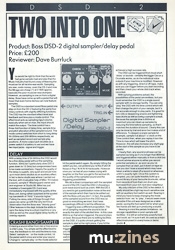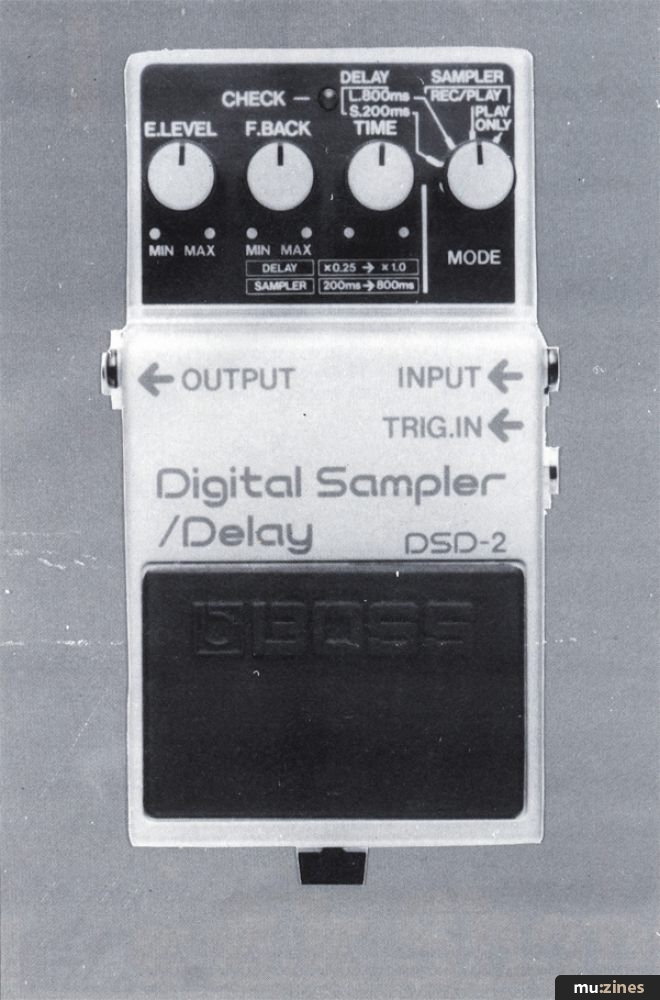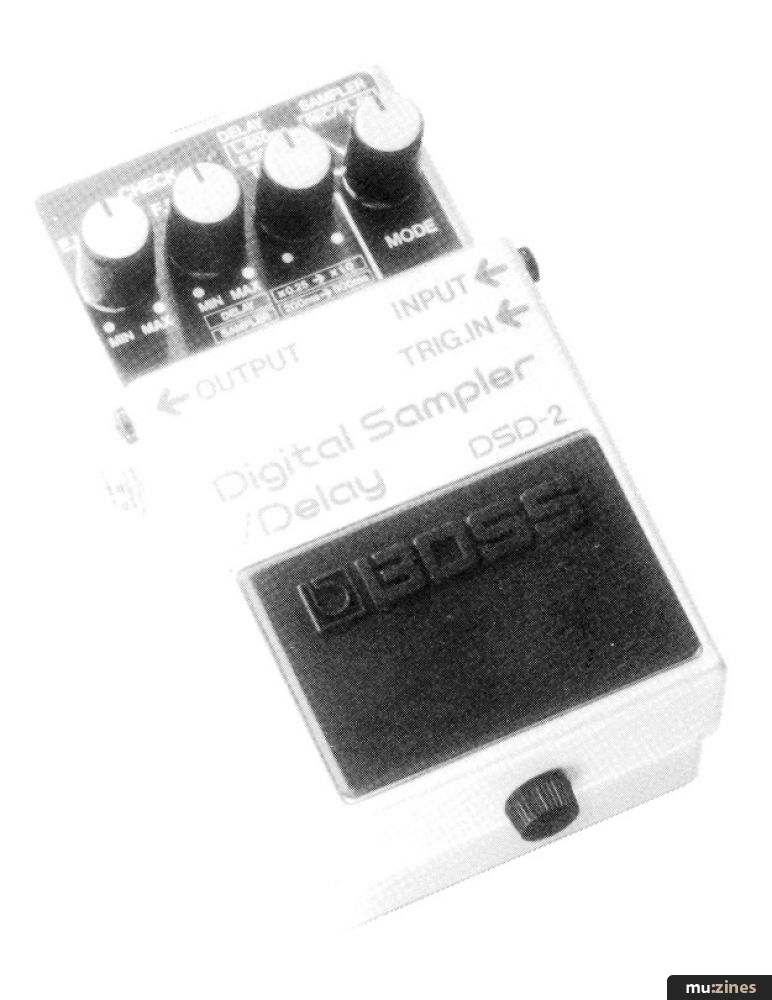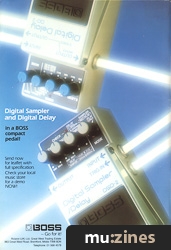Magazine Archive
Home -> Magazines -> Issues -> Articles in this issue -> View
Two Into One | |
DSD-2Article from Electronic Soundmaker & Computer Music, August 1985 | |
Roland's delay sampling pedal

You would be right to think that the world I had gone sample mad and also that the Music Industry had found a way of fleecing the musician for all he/she was worth. Sampling you see, costs money, even the DS-3 and now the Mirage are cheap (?) at £1600 approx, basically the poor musician was stumped. However, as sampling is one on from a digital delay, Boss have come up with a pedal that will mean that even home demos can now feature samples.
The DSD is a standard sized Boss pedal one step on from the DD-2 featuring the same four rotary controls with slightly differing functions. The DSD has the standard effect level and feedback and time plus a mode control. The effect level acts as sampling input volume; basically when set on max, the input should match the output. The time control has a three-fold function of delay time, sample time and pitch alteration of the sampled sound. The mode control switches from short to long delay 50-200ms and 200-800ms respectively, as well as sample record and sample play positions. A mono output jack doubles as a power switch if a battery is used and we have two input jacks - signal and trigger.
DELAY
With a delay time of 50-800ms the DSD would be a fine delay pedal without the sampling function. 50ms isn't particularly slow (DD-2 goes down to 12.5ms) but compromises have to be made somewhere. Happily the quality of the delay is superb, very quiet and would hold up in most demo studios as an auxiliary effect. In fact a demo studio was where I carried out the test, with invaluable help of Mike 'if it makes a sound, sample it' Westergaard - owner and ace engineer at Studio 99. Mike has just installed a Greengate DS-3 and was immediately impressed with the quality of the Boss unit, being rather surprised at the quoted top bandwidth of 7kHz "it sounds higher." Putting the delay side of things through their paces we came up with the very technical observation that the Boss was "bloody good". Other features in this dept, include the ability to sync the delay time to a drum machine or any click as well as the usual digital delay facility of overlay repeats.
CRASH! BANG! SAMPLE!
Entering a sound either from mic or line source is child's play. You simple set the effect level to max, the feedback to min and the time to max. Select 'sample rec.' on the mode control, hit the pedal switch once and enter your sound. Change to 'sample play' on the mode selector hit the pedal-switch again. By simply hitting the switch you too, can pretend you're the (F)Art Of Noise or Paul 'N-N-N-N' Hardcastle. However once you've had all your mates crying with laughter on the floor you get to the serious bit, the quality of the sampled sound and the triggering possibilities.
We did a direct comparison with the sampled sound of the DS-3 and the DSD-2 choosing a pure wave sound such as a tom. With the DS-3 you tend to get quantisation noise at the end of the sample which then has to be edited out, with the Boss unit you don't. In fact, the quality of the sampled sound from the DSD was so good on everything we tried, that it was exceedingly difficult to tell the difference.
Triggering was a different proposition. The art of sampling requires the sound to be at exactly the start of the allotted time - in this case 800ms so that when triggered, the sound plays on beat. Because there are no editing facilities on the DSD, it's quite a knack getting the sample to start at the right place, if you hit the button too soon the sample is delayed when triggered and conversely if you're too late then you clip the start of the sample. This isn't helped by the less than touch sensitive pedal switch, but after a while and by hitting the switch on beat with the sound to be sampled we achieved a high success rate.
The DSD can be triggered from most short 'clicks' or sounds - certainly the trigger Out on a Drumatix works, as do the individual voice outputs if your machine is modified. However as with any triggering, direct or off-tape, make sure you can trigger before you start recording and then check your whole click track when recorded.
With syncing problems solved, the possibilities of the pedal are endless, but you must remember the DSD is a single sound sampler with no storage facility. You can only 'play' the DSD with the time control which will then change the pitch of your sample, but it's not accurate enough to play parts. It is good for tom rolls or deepening snares and tightening bass drums as well as tuning a sample to a track. Because the sample time is 800ms at maximum you can clean up samples by reducing the time before sampling, so that it matches the duration of sound. Clearly this can only be done by trial and error but makes a lot of difference. To deepen a snare sample for example, sample it at about 1 o'clock on the Time control then, when you replay it turn the Time to max which will lower the pitch. However, this will also increase any slight gap at the start of the sample so you have to be careful.
Clearly then, any sound or phrase can be sampled (so long as it's no longer than 800ms) and triggered either manually or from a click but I would advise anyone to either pre-record potential samples or, as soon as you've sampled that car start, put it down on tape so that you don't lose a sound which may have taken a while to steal off a record or wherever, until it's exactly right. Once this system is adopted, you can quite feasibly build up a sound library of your favourite drums etc. either from records of from that Linn drum you borrowed from your rich next door neighbour.
My only criticism of the DSD is the switch. It really should be a light tap touch sensitive one with an auxiliary foot switch as well. Bearing in mind you have to keep changing the mode selector from 'rec' to 'play', it would seem more sensible if the unit was designed as a table pedal, saving the foot switch bit for when your two hands are tied up in producing a sound.
Bearing in mind the pedals limitations - no storage capabilities or post-sample edit facilities - it is still an extremely powerful tool and could, as I'm sure it will, be used as a main effect/instrument in every home or demo studio.
Price: £200
Roland: (Contact Details)
Thanks Mike Westgaard at Studio 99 ((Contact Details)), for his help in this test and sound recording.
Also featuring gear in this article
Boss DSD-2
(12T Aug 85)
Boss DSD-2 Digital Sampler - Effectscheck
(IM Aug 85)
Boss DSD2
(EMM Oct 85)
Pedal Power - Boss DSD2 Sampler/Delay
(HSR Nov 85)
Browse category: Guitar FX > Boss
Publisher: Electronic Soundmaker & Computer Music - Cover Publications Ltd, Northern & Shell Ltd.
The current copyright owner/s of this content may differ from the originally published copyright notice.
More details on copyright ownership...
Review by Dave Burrluck
Help Support The Things You Love
mu:zines is the result of thousands of hours of effort, and will require many thousands more going forward to reach our goals of getting all this content online.
If you value this resource, you can support this project - it really helps!
Donations for November 2025
Issues donated this month: 0
New issues that have been donated or scanned for us this month.
Funds donated this month: £0.00
All donations and support are gratefully appreciated - thank you.
Magazines Needed - Can You Help?
Do you have any of these magazine issues?
If so, and you can donate, lend or scan them to help complete our archive, please get in touch via the Contribute page - thanks!







